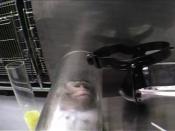Animal testing has for a long time been a much debated moral issue. For many, this kind of testing has been the only kind of hope for developing new medicines and treatments for illness. For others, it is an unacceptable and unnecessary cruel way of exploiting animals for our own purposes. Treatments for illnesses such as tuberculosis, diabetes, kidney failure and asthma have all been discovered, and vaccinations against polio, diphtheria, tetanus and measles for example have all been found.
There are strict laws in place for using animals for testing and research purposes, so as to minimise any pain and distress the animals may encounter.
The Animals (Scientific Procedures) Act 1986 ensures that the usage of animals must be kept to a minimum and animals may only be used when no other method of testing is available.
The law states that the testing must be humane and only if no other method can be used in the particular procedure.
By "humane", the law means that painkillers and anaesthetics must be used when necessary, and if an animal is in severe pain it must be painlessly killed immediately to eliminate it's suffering.
The majority of animals used in research are mice, rats and other rodents. In fact, they make up around 84% of animals used. Animals more commonly used as pets, for example dogs and cats, make up only around 0.4% of animals used.
The reason animals are used is that they have more DNA similarities to a human than you would at first think. Their bodies will react in a similar way to a human body would to drugs. Also, rodents are easily cared for. Their short lifespan means that the long term effects of medicines can be seen more quickly. Animals are specially bred for use in testing.


